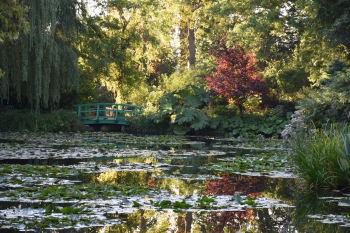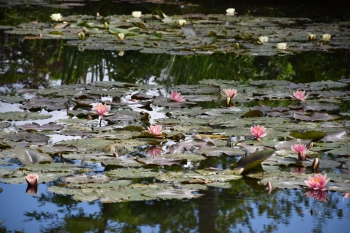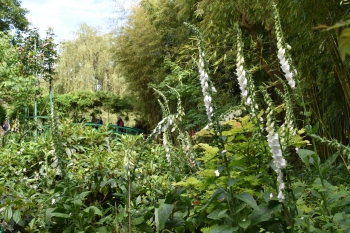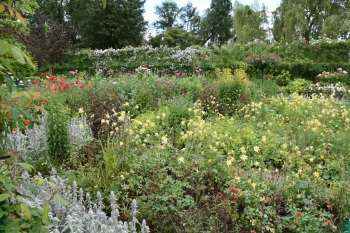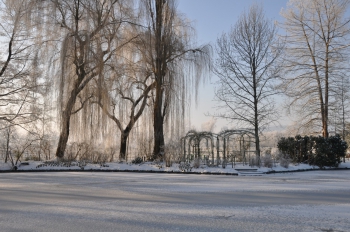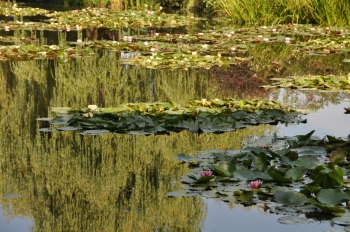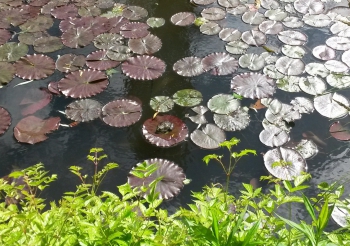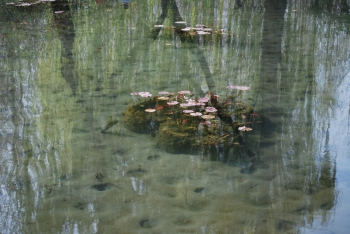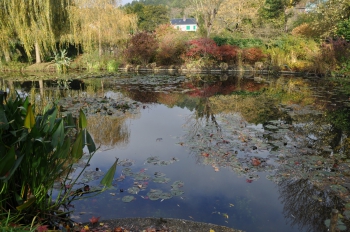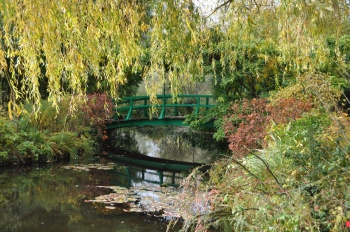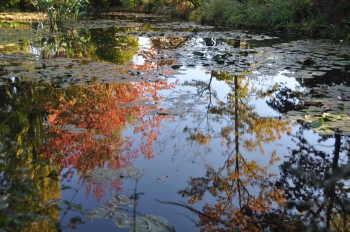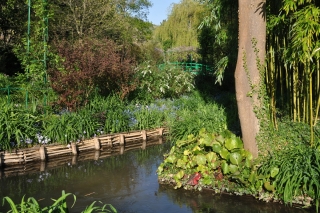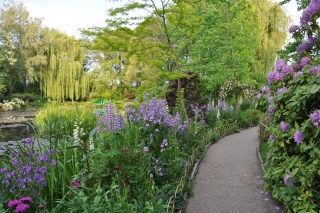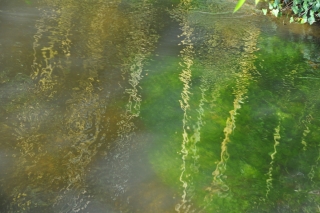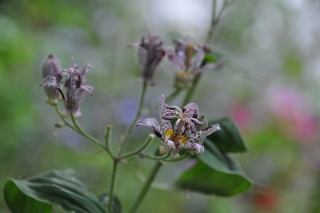Early in the morning, the rising sun shines through the foliage in Monet’s water garden at Giverny, in a corner that is shaded the rest of the day.
Entries Categorized as 'Water-Garden'
Giverny’s Water Garden
September 2, 2016
Giverny in June
June 16, 2016
In June, all the water lilies flower on Monet’s pond, beautiful and delicate corollas in different tones of pink and soft yellow or white.
The foxgloves stand out everywhere in the garden, like giant sentinels that tower far above our heads.
The long lasting columbines team with other small flowers like geums and catchfly to offer a light foam of little dots of color. Elsewhere, annual poppies turn the garden pink or red.
June is the month of roses. At Giverny they stand or climb on dozens of metallic structures or on fences. Their scent is a delight…
Pads
April 15, 2016
Winter Time
February 20, 2016
This is not the winter we are having at Giverny this year. The last time Monet’s water lily pond looked that way was in 2012.
It was so beautiful then! I roamed in the gorgeous yet closed garden and couldn’t look and shoot enough.
The landscape turned white is not that frequent at Giverny. Although we do get a few flakes every winter and a few nights of frost, generally the weather is more humid than cold. It is overcast, it rains, but not cats and dogs, only kittens and puppies, you know.
Patience. All this will soon be over. Fondation Claude Monet opens rain or shine on March 25, 2016, and the seven-month flower show wil be more beautiful than ever.
Mirror
August 2, 2015
When there is no wind at all, the water lilies painted by Monet at Giverny seem to be floating in the air.
The surface of the pond is such a perfect mirror that the water turns invisible.
The rafts of water lilies resemble flying carpets en route for a long trip to mysterious countries.
The Frog: Time Sure is Fun When You’re Having Flies
May 18, 2015
Claude Monet’s water lily pond in May, when frogs croak and sit on pads…
The first Nympheas have opened! They will flower until September.
I’m grateful to the kind visitor that quoted the above title, and then patiently explained to me the related colloquialism and thus the joke. In French we don’t have the same image. We say that time passes in a lightning, le temps passe en un éclair. The way each language expresses reality and experiences its own way is an endless source of amazement and amusement to me.
The Crystal Clear Pond
February 19, 2015
As long as the water is still cold, the algaes don’t feel like growing. They wait patiently for better times to come.
In March, the water of Monet’s pond is so clear that the bottom looks close, offering shamelessly all its details to the view.
The uneven surface of the layer of mud resembles the moon, with mysterious craters everywhere. The planters of water lilies pop up in this desert like a lunar buggy.
The brave first leaves have made their way through the water to reach the surface, looking for sun and energy. They are still purple but will soon turn green.
In back light, when the weather is fine, innumerable stars twinckle on the surface where the light kisses the water.
This crystal clear water is the show awaiting the first Giverny visitors. In April, days get longer, warmer, and the inviting sunbeams awake grass, flowers, trees and algaes alike.
Some years, the water looses its transparency and gets almost milky, to my delight, because I like the way it absorbs the colors, I find it lovely. After a while the water clears up again.
More Peaceful Than Ever
November 24, 2014
Fall atmosphere in Monet’s gardens at Giverny.
The picture was taken from the steps of the dock next to the water lily pond.
On the left, the green leaves of pontederias.
The red shrub on the opposite bank is a Japanese maple.
In the distance appears the pink house with green shutters, Monet’s home for 43 years.
On the right, through the branches, the third studio where Monet painted his biggest water lilies panels.
November at Giverny
November 10, 2014
Do you want to have a look at the Monet Garden while it is closed for the winter?
Here is the Japanese bridge as it was this morning.
Giverny is now closed for five months.
The village will awake again next spring.
The first day for visiting the gardens will be Saturday 28 March, 2015.
Fall Colors
October 22, 2014
Yesterday I guided very charming hawaian guests at Giverny. It was nice to look at Monet’s gardens through their eye from Hawai. They reminded me that fall doesn’t exist on their island. It is summer all year round. Discovering the special spirit of this season sounded very exciting for them. Autumn has started to work its magic on the foliage. The three sweet gum trees reflect their reds and oranges into the water lily pond. For us, who know what will come next, this dramatic show of the saison, despite of its beauty, has a special flavour of nostalgia and melancholia intertwined.
Water Lilies in their Glory
June 7, 2014
That many.
That plenty.
This is how the water lilies are blooming right now at Giverny. Pink, salmon, yellow, white.
For more pictures of Giverny, you may also enjoy my photo gallery Giverny Photo and, even if you don’t read French, my other blog Giverny News that I’ve been writing for 8 years.
I would like to dedicate this post to Marjorie, whom I met this week in the garden while I was photographying for the blogs. Marjorie is a painter and gives painting classes in Monet’s gardens after closing time. She came to me, ‘Are you Ariane?’ She wanted to say thank you for the blog.
You know, Giverny is a little heaven. Minutes ago, I was sitting in the garden waiting for a cloud to go away from the sun, and doubting. Is it still meaningful to go on with the blogs? When the sun came back, I got up for more pictures, and I met Marjorie and her gratefulness. She came to me like an angel. Life has the answer, when we ask a question. I’m grateful to you, Marjorie.
Perspective
May 17, 2014
Claude Monet designed his water garden from scratch, turning a marshland into a beautiful waterscape to paint.
His eye as a painter can be noticed in the much thought of composition of the garden.
Every where perspectives draw the sight, offering a ready made composition to the artist.
Purple Harmony
January 15, 2014
Late May or early June, Monet’s garden turns mostly purple. On the pond banks, mauve ladies’ rocket matching exactly the big rhododendrum on the other side of the path combines with mauve or blue lupines, pink sweet Williams, white fox gloves and blue sages. The mauve turns progressively into pink to fit with the beautiful tree of roses. This scene doesn’t last long, but it is of great effect. It follows the bulbs period and will be followed by summer flowers. (click for more details)
Colors on the Water
December 9, 2013
The golden bamboos planted by Monet on the island of his water garden at Giverny reflect into the flowing water of the rivulet le Ru, producing ever changing broken lines.
Under the surface, the bright green of algaes.
A magnet for the eye…
(Click on the picture to enlarge.)
Tricyrtis
November 17, 2013
The common name of this beautiful flower that grows in Monet’s water garden is a bit strange: it’s called toad lily.
The appearance of this perennial is more orchid like.
It requires a moist soil, as do toads, part shade under trees, and in these conditions it is very hardy.
The tricyrtis appears late in season.
This picture was taken in October.
